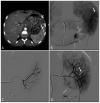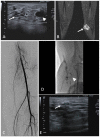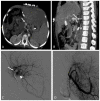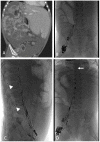Embolization in Pediatric Patients: A Comprehensive Review of Indications, Procedures, and Clinical Outcomes
- PMID: 36431102
- PMCID: PMC9696500
- DOI: 10.3390/jcm11226626
Embolization in Pediatric Patients: A Comprehensive Review of Indications, Procedures, and Clinical Outcomes
Abstract
Embolization in pediatric patients encompasses a large spectrum of indications, ranging from the elective treatment of congenital diseases of the cardiovascular system to the urgent management of acute hemorrhagic conditions. In particular, the endovascular treatment of central and peripheral vascular malformations and hypervascular tumors represents a wide chapter for both congenital and acquired situations. Thanks to the progressive availability of low-profile endovascular devices and new embolic materials, the mini-invasive approach has gradually overtaken surgery. In this review, the main embolization procedures will be illustrated and discussed, with a focus on clinical indications and expected outcomes. The most recent mini-invasive techniques will be described, with hints on the cutting-edge devices and embolic materials.
Keywords: bleeding; embolization; endovascular; mini-invasive approach; pediatric.
Conflict of interest statement
The authors declare no conflict of interest.
Figures













Similar articles
-
Preoperative embolization of hypervascular pediatric brain tumors: evaluation of technical safety and outcome.Childs Nerv Syst. 2013 Nov;29(11):2043-9. doi: 10.1007/s00381-013-2128-2. Epub 2013 May 4. Childs Nerv Syst. 2013. PMID: 23644575
-
Recent advances in endovascular techniques for management of acute nonvariceal upper gastrointestinal bleeding.World J Gastrointest Surg. 2011 Jul 27;3(7):89-100. doi: 10.4240/wjgs.v3.i7.89. World J Gastrointest Surg. 2011. PMID: 21860697 Free PMC article.
-
Clinical significance of embolic events in patients undergoing endovascular femoropopliteal interventions with or without embolic protection devices.J Vasc Surg. 2014 Feb;59(2):359-367.e1. doi: 10.1016/j.jvs.2013.07.119. J Vasc Surg. 2014. PMID: 24461861 Free PMC article.
-
Glue, Onyx, Squid or PHIL? Liquid Embolic Agents for the Embolization of Cerebral Arteriovenous Malformations and Dural Arteriovenous Fistulas.Clin Neuroradiol. 2022 Mar;32(1):25-38. doi: 10.1007/s00062-021-01066-6. Epub 2021 Jul 29. Clin Neuroradiol. 2022. PMID: 34324005 Free PMC article. Review.
-
Management of extracranial arteriovenous malformations of the head and neck.Auris Nasus Larynx. 2020 Apr;47(2):181-190. doi: 10.1016/j.anl.2019.11.008. Epub 2019 Dec 18. Auris Nasus Larynx. 2020. PMID: 31862283 Review.
Cited by
-
Novel Use of Bland Trans-Arterial Embolization for Hepatoblastoma: A Case Report.Pediatr Transplant. 2025 Aug;29(5):e70121. doi: 10.1111/petr.70121. Pediatr Transplant. 2025. PMID: 40556272 Free PMC article.
-
Pediatric hemoptysis: diagnostic and interventional challenges.Pediatr Radiol. 2024 Oct;54(11):1769-1784. doi: 10.1007/s00247-024-06002-7. Epub 2024 Aug 12. Pediatr Radiol. 2024. PMID: 39128986 Review.
-
Ultrasound-Guided Percutaneous Sclerotherapy With Bleomycin for Management of Infantile Subcutaneous Hemangioma: A Case Report.Clin Case Rep. 2025 Feb 11;13(2):e70143. doi: 10.1002/ccr3.70143. eCollection 2025 Feb. Clin Case Rep. 2025. PMID: 39944862 Free PMC article.
References
-
- Venturini M., Piacentino F., Coppola A., Bettoni V., Macchi E., De Marchi G., Curti M., Ossola C., Marra P., Palmisano A., et al. Visceral Artery Aneurysms Embolization and Other Interventional Options: State of the Art and New Perspectives. J. Clin. Med. 2021;10:2520. doi: 10.3390/jcm10112520. - DOI - PMC - PubMed
Publication types
LinkOut - more resources
Full Text Sources

